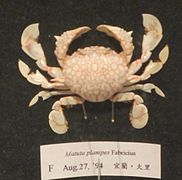Matutidae
| Matutidae Temporal range:
| |
|---|---|

| |
| Ashtoret lunaris, dorsal side | |

| |
| Male Ashtoret lunaris, ventral side | |
| Scientific classification | |
| Kingdom: | |
| Phylum: | |
| Subphylum: | |
| Class: | |
| Order: | |
| Infraorder: | |
| Superfamily: | |
| Family: | Matutidae |
| Genera | |
|
See text | |
Matutidae is a family of crabs, sometimes called moon crabs,[2] adapted for swimming or digging. They differ from the swimming crabs of the family Portunidae in that all five pairs of legs are flattened, rather than just the last pair, as in Portunidae. Crabs in the Matutidae are aggressive predators.[3]
Taxonomy[]
Traditionally, this taxon contained the single genus Matuta, and was considered a subfamily of the Calappidae.[3] Now, the group is ranked as a family and six genera (four extant and two fossil) are now recognised.[4] Although placed in the Calappoidea, it is not clear that Matutidae and Calappidae are closely related.[5]
- Ashtoret Galil & P. F. Clark, 1994
- † De Angeli & Marchiori, 2009
- Izanami Galil & P. F. Clark, 1994
- Matuta Weber, 1795
- Mebeli Galil & P. F. Clark, 1994
- † Müller & Galil, 1998
Fossil record[]
is known only from Hungarian fossil deposits of Middle Miocene age.[6] was described from the Middle Eocene of Italy in 2009.[7] Fossils of Ashtoret have also been found in Miocene deposits in Japan.[6]
References[]
- ^ Peter Davie & Michael Türkay (2009). "Matutidae". World Register of Marine Species. Retrieved January 17, 2010.
- ^ Ria Tan (October 2008). "Moon crabs, Family Matutidae". .
- ^ a b "Family MATUTIDAE De Haan, 1835". Australian Faunal Directory. Department of the Environment, Water, Heritage and the Arts. October 9, 2009. Archived from the original on April 1, 2011. Retrieved January 17, 2010.
- ^ Sammy De Grave; N. Dean Pentcheff; Shane T. Ahyong; et al. (2009). "A classification of living and fossil genera of decapod crustaceans" (PDF). Raffles Bulletin of Zoology. Suppl. 21: 1–109. Archived from the original (PDF) on 2011-06-06.
- ^ Peter K. L. Ng; Danièle Guinot & Peter J. F. Davie (2008). "Systema Brachyurorum: Part I. An annotated checklist of extant Brachyuran crabs of the world" (PDF). Raffles Bulletin of Zoology. 17: 1–286. Archived from the original (PDF) on 2011-06-06.
- ^ a b Hiroaki Karasawa (2002). "First record of a Miocene matutid crab (Crustacea: Decapoda: Brachyura) from Japan" (PDF). . 29: 93–94. Archived from the original (PDF) on 2005-12-20.
- ^ A. de Angeli & L. Marchiori (2009). "Eomatuta granosa n. gen., n. sp. (Decapoda, Brachyura, Matutidae), nuovo crostaceo dell'Eocene dei Monti Berici (Vicenza, Italia settentrionale)". Lavori Società Veneziana di Scienze Naturali. 34: 105–110. Archived from the original on 2011-07-22.
- Calappoidea
- Taxa named by Wilhem de Haan



